The History and Care of Halloween Costumes: A Complete Guide for Costume Lovers
Halloween isn’t just about sweets, scares, or spooky decorations – it’s a vivid expression of creativity, community, and transformation. For one night, people shed their everyday identities and become someone—or something—else entirely. From the haunting masks of ancient Celts to the pop-culture icons of TikTok, Halloween has evolved into a global fashion phenomenon. But amid the excitement and artistry, there’s a practical truth most overlook: those costumes, often made from fragile fabrics, glittering sequins, or synthetic blends, need special care to survive the night—and the wash.
Understanding the evolution of Halloween costumes is essential for appreciating the creativity behind them. From ancient traditions to modern fashion statements, Halloween costumes have transformed while still celebrating the spirit of the holiday.
At Hampstead Garment Care, we believe your Halloween costume is a work of art that deserves to be preserved and cherished. This guide takes you on a journey through the fascinating history of Halloween costumes, explores how styles have evolved through the centuries, and offers expert advice on keeping your spooky ensembles in pristine condition. Whether you’re a parent preserving your child’s first trick-or-treat outfit or an adult cosplayer protecting an elaborate creation, understanding proper care ensures your costume lasts beyond October 31.
In recent years, Halloween costumes have embraced various themes, including environmental consciousness, with many opting for sustainable and ethical choices. These trends reflect a growing awareness of the environmental impact of fast fashion.
1. The Ancient Origins of Halloween
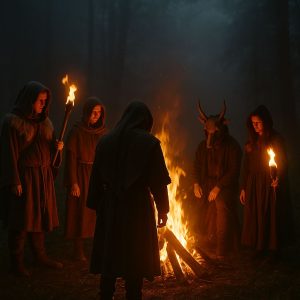 1.1 The Celtic Festival of Samhain
1.1 The Celtic Festival of Samhain
Halloween’s roots lie in the Celtic festival of Samhain, celebrated thousands of years ago across Ireland, Scotland, and northern France. The Celts believed that on the night of October 31, the boundary between the living and the dead blurred. Spirits could roam freely, bringing blessings—or mischief. To protect themselves, villagers lit great bonfires, offered food to wandering souls, and wore disguises made of animal hides and heads to confuse malevolent entities. These early costumes were meant not to entertain, but to survive.
1.2 Christian Influence: From Samhain to All Hallows’ Eve
When Christianity spread through Europe, Church leaders sought to integrate pagan traditions into new religious observances. In the 8th century, Pope Gregory III declared November 1 as All Saints’ Day, honouring saints and martyrs. The evening before became known as All Hallows’ Eve, eventually shortened to Halloween. Though the holiday adopted a Christian tone, echoes of the old Celtic beliefs remained. Fire, masks, and masquerade continued to symbolise humanity’s attempt to face—and laugh at—its fears.
1.3 Folklore, Ghosts, and Early Disguises
As we celebrate Halloween, it is essential to remember the significance of each costume. Halloween costumes allow us to express ourselves and connect with cultural narratives that transcend generations.
As centuries passed, people began to adopt the custom of dressing as spirits, angels, or demons. During medieval souling, children and the poor would visit homes, offering prayers for the dead in exchange for food or coins. These early costumes often featured white shrouds, black veils, or animal masks, blending superstition and playfulness. Over time, this evolved into mumming—performing short skits or songs in disguise—spreading through Scotland and Ireland before crossing to North America.
2. Evolution of Halloween Costumes Through the Ages
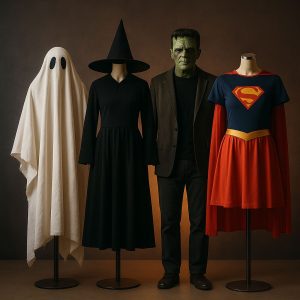 Today, Halloween costumes are more diverse than ever, ranging from spooky to whimsical. This evolution showcases the creativity and innovation of both costume designers and wearers.
Today, Halloween costumes are more diverse than ever, ranging from spooky to whimsical. This evolution showcases the creativity and innovation of both costume designers and wearers.
2.1 19th Century: Homemade Hauntings
In the 1800s, Halloween was a modest, community-based celebration. Costumes were handmade from whatever was available—bedsheets, straw hats, soot, and paper. Ghosts and witches dominated the scene, representing the mysterious forces of life and death. There was no glamour, only imagination and creativity. These DIY disguises reflected both thrift and artistry—a stark contrast to today’s store-bought looks.
2.2 Early 20th Century: Commercialisation Begins
As industrialisation flourished, Halloween costumes entered the marketplace. Companies like Dennison and Beistle in America produced paper masks and crepe-paper costumes—simple, colourful, and affordable. By the 1930s and 40s, mass-produced costumes featuring characters like skeletons, clowns, and devils flooded the market. The materials, however, were far from durable: fragile paper and flammable synthetics often tore after one night of fun.
2.3 The Mid to Late 20th Century: Pop Culture Dominates
Post-war prosperity brought television and film into every home—and with it, new icons. Frankenstein, Dracula, The Mummy, and later Batman and Wonder Woman, became household favourites. Halloween evolved into a showcase of popular culture. By the 1980s and 1990s, polyester costumes and plastic masks ruled the shelves, cheap to produce but tough to clean. The rise of mass media turned Halloween into a multi-billion-pound industry.
2.4 21st Century: The Age of Fast Fashion and Cosplay
In the digital era, Halloween fashion has evolved into a blend of tradition, fandom, and influencer culture. From celebrity-inspired looks to elaborate cosplay builds, costumes today can cost anywhere from £10 to £1,000. The downside? Fast fashion’s reliance on low-quality materials means many garments are not designed for longevity or reusability. That’s where professional cleaning makes all the difference.
3. Symbolism Behind Iconic Halloween Costumes
As you explore the symbolism behind various Halloween costumes, consider how these choices reflect personal beliefs and cultural identities.
Every costume tells a story. Here are some of the deeper meanings behind familiar Halloween icons:
-
Ghosts: They symbolise the thin boundary between life and death. Wearing white sheets was once thought to help the living blend in with spirits wandering on Samhain night.
-
Witches: Beyond their spooky reputation, witches embody empowerment, rebellion, and wisdom. The black hat and broom became symbols of women’s independence in folklore.
-
Skeletons and Skulls: A timeless reminder of mortality and transformation, reminding us that death is part of life’s eternal cycle.
-
Animals and Monsters: Cats, bats, wolves, and zombies all represent primal fear—the uncanny made visible. Dressing as these creatures allows us to explore our inner darkness in a safe and controlled manner.
4. Modern Halloween Fashion and Social Trends
 The influence of social media on Halloween costumes cannot be overlooked, as platforms inspire creativity and create communities around shared interests in costume design and aesthetics.
The influence of social media on Halloween costumes cannot be overlooked, as platforms inspire creativity and create communities around shared interests in costume design and aesthetics.
4.1 The Social Media Effect
Platforms like Instagram, YouTube, and TikTok have made Halloween a fashion runway. Influencers and makeup artists post tutorials weeks in advance, sparking trends overnight. Costume competitions, themed parties, and viral makeup challenges have made Halloween more glamorous than ever—but also more fabric-intensive. Sequins, latex, metallic paints, and faux fur are now part of the norm, and they all require careful handling.
4.2 Sustainability Takes Centre Stage
As the world becomes increasingly eco-conscious, there is a growing interest in sustainable Halloween fashion. Renting costumes, reusing materials, or upcycling old clothing has become a stylish alternative to fast fashion. At Hampstead Garment Care, we support this sustainable shift by offering eco-friendly cleaning solutions that extend a costume’s life while minimising chemical waste and water consumption.
Investing in quality Halloween costumes ensures that they can be cherished and worn for years to come, allowing for family traditions to be passed down through generations.
4.3 Group, Couples, and Family Themes
From spooky duos to full ensemble casts, coordinated costumes are a significant trend. Families dress as entire movie casts; offices host themed parties. This surge in participation means a bigger demand for reliable cleaning and preservation services once the festivities end.
5. The Hidden Challenges of Costume Fabrics
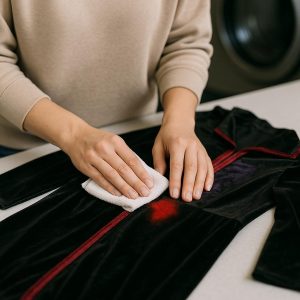
Halloween costumes may look spectacular, but their construction often hides serious cleaning hazards. Under the dazzling surface of sequins and shimmering fabrics lies a fragile mix of fibres, adhesives, and finishes that react differently to heat, moisture, and chemicals. Understanding what your costume is made of—and how each material behaves—is the first step in preserving it beyond one night.
5.1 Common Materials and Their Quirks
-
Polyester/Nylon: Lightweight, shiny, and easy to dye, these fabrics are the backbone of most modern costumes. However, they can easily melt or shrink when exposed to high heat. Even something as simple as ironing too close or using a tumble dryer can cause irreversible damage. Polyester also has an affinity for oily stains, meaning makeup, sweat, and body lotion can leave lingering marks that are hard to remove without professional solvents.
-
Velvet, Tulle, and Lace: These luxurious materials are beloved for their dramatic flair, but they require extra caution. Velvet can flatten if pressed too firmly, tulle tears easily when snagged by jewellery, and lace can distort its pattern if agitated in water. Always store these garments hanging or padded to maintain shape, and never fold them sharply.
Proper care extends the life of your Halloween costumes, making them ready for many years of joyful celebrations.
-
Sequins, Glitter, and Beads: Costumes featuring sparkle and shine often use adhesives to attach decorative elements rather than stitching. These glues may dissolve in water, softening or even detaching embellishments during cleaning. Glitter can transfer or bleed colour under friction. Professional cleaners test each solvent first to avoid dulling or melting these delicate features.
-
Faux Leather & PVC: Often used for superhero or villain costumes, these materials mimic the glossy texture of genuine leather but are far more sensitive. Without conditioning, they can crack, peel, or stiffen over time. Exposure to heat or direct sunlight accelerates deterioration, so they should be wiped gently with a damp cloth and stored in a cool, shaded area.
-
Metallic or Foil Fabrics: Popular in futuristic or fantasy costumes, these fabrics use thin foil coatings that flake or fade under pressure. Always clean using minimal agitation and never iron directly on the shiny surface.
Understanding these quirks allows wearers to anticipate problems before they arise and make smarter decisions about when to hand a piece over to professionals.
5.2 Frequent Costume Mishaps
Halloween parties are lively and unpredictable, and with every drink poured and dance floor moment, costumes face a real workout. Here’s a deeper look at the most frequent mishaps and how they occur:
-
Fake blood, foundation, and makeup stains: These are among the most difficult to remove due to their oil- or dye-based composition. Fake blood often contains food colouring or theatrical pigments that penetrate fibres quickly, leaving stubborn red or brown marks. Foundation and heavy stage makeup, meanwhile, leave greasy residues that cling to synthetic fabrics. Gently blot rather than rubbing, as friction can spread the stain.
-
Sweat odours trapped in synthetic fabrics: Many costumes made of polyester or vinyl don’t breathe, trapping body heat and moisture. The result is odour build-up, especially in underarm or neckline areas. These smells can linger even after washing because the synthetic fibres repel water. Professional solvents neutralise these odours by dissolving trapped oils.
So, whether you opt for a classic ghostly figure or something more modern, your Halloween costume is an essential aspect of celebrating the holiday.
-
Spilt food and alcohol during parties: Drinks like red wine, cocktails, or sauces are common culprits. Acidic or sugary spills can stiffen the fabric and attract bacteria if left untreated overnight. Always dab spills immediately with a clean cloth or napkin, and avoid applying heat, which can set the stain.
-
Glitter shedding and adhesive residue in seams: Glitter is beautiful, but it can be relentless. Once applied with glue or spray adhesive, it tends to migrate onto everything. When removed incorrectly, it can scratch delicate fabrics or dull shiny finishes. Professional cleaners use gentle static-removal tools to lift loose particles without damaging the weave.
-
Tearing at hems and seams due to tight fits or dancing: Many costumes are designed more for appearance than endurance. Tight seams, thin stitches, and low-quality thread often tear when you move, stretch, or dance. Reinforce vulnerable areas with a few extra stitches before wearing, and never try to repair tears with super glue—it stiffens the fabric and causes more damage later.
Understanding how these mishaps happen helps costume lovers anticipate potential issues and choose more innovative care solutions right after the celebration.
5.3 The Risks of DIY Cleaning
At-home cleaning might seem tempting—after all, a quick rinse or spin cycle seems like the easiest way to get rid of fake blood or glitter—but this approach can be disastrous. Most Halloween costumes are made from a mix of materials: a bit of polyester here, some glued-on sequins there, and perhaps even faux leather trims. Each of these reacts differently to heat, friction, and moisture. Using hot water or a tumble dryer can melt plastic decorations or shrink delicate fabrics beyond repair. Even gentle machine cycles can cause mesh or lace to tear, while strong detergents strip dyes and dissolve the adhesives that hold embellishments in place.
DIY spot treatments are just as risky. Rubbing alcohol, bleach, or stain removers not designed for speciality fabrics may leave discoloured patches or brittle spots where glue once was. Glitter, metallic finishes, and painted designs often smear when exposed to the wrong solvent. Drying near heat sources, such as radiators, can cause synthetic fabrics to warp or create sticky surfaces that attract more dirt.
If you must attempt home cleaning, always test any product on a hidden area first. Use cold water only, and air-dry on a flat surface away from direct sunlight. But even with care, results can be unpredictable. For costumes with sentimental or financial value, professional cleaning is the safest and most effective solution, ensuring that every bead, sparkle, and stitch remains intact for the next celebration.
Protecting the integrity of your Halloween costumes is vital, whether through professional cleaning or careful storage methods.
6. Expert Costume Care: Before and After the Party
6.1 Before You Head Out
Before stepping into the night’s festivities, preparation is key. Think of it as pre-party costume maintenance. Check every inch of your outfit under good lighting—sequins, threads, hems, buttons, and zips. Minor issues, such as a loose bead or fraying edge, may seem trivial, but during an active party, they can quickly escalate into noticeable damage. Reinforce weak seams with light stitching or clear fabric adhesive if needed.
If your costume includes delicate trims or lace, consider adding a thin cotton lining or wearing a slip underneath to prevent friction. Spot-treat visible marks or deodorant stains with a mix of mild detergent and cold water using a soft cloth—avoid circular rubbing, which can damage fibre texture. After prepping, place the entire outfit in a breathable garment bag (preferably made of cotton) to protect it from dust and moisture while allowing for airflow. Avoid plastic covers; they trap humidity that can encourage mildew. Lastly, travel smart—carry accessories separately in small pouches and avoid weighing down your costume with heavy jewellery or props that may tear the material.
6.2 After the Party
The real challenge begins once the lights go out. Costumes often come home sweaty, glittery, and occasionally scented with the aromas of late-night snacks or party drinks. Start by carefully shaking off surface debris outdoors, including glitter and crumbs. Then, gently brush the costume with a soft garment brush to remove finer particles. If the costume feels damp, hang it to air-dry naturally in a shaded, ventilated area—never on radiators or in direct sunlight, as this can cause fading of colours and warping of synthetics. Turn the garment inside out to help release body odours and moisture trapped in inner linings.
For costumes with sequins, metallic thread, or glued embellishments, skip the iron entirely. Instead, use a garment steamer on the lowest setting and maintain a distance of at least 20 cm, placing a clean cotton cloth as a barrier to protect the fabric. If there are makeup or drink stains, don’t attempt to scrub them out yourself; these marks often set deeper when rubbed. Gently dab them with cold water and bring the item to Hampstead Garment Care as soon as possible. Our professional restoration process can lift cosmetic residue, remove stubborn stains, and refresh your costume’s structure—so it’s ready to dazzle again next year.
7. Eco-Friendly Cleaning and Storage Techniques
 Integrating eco-friendly practices into the care of your Halloween costumes allows you to enjoy the festivities while remaining mindful of the environment.
Integrating eco-friendly practices into the care of your Halloween costumes allows you to enjoy the festivities while remaining mindful of the environment.
Caring for costumes sustainably isn’t just good for the planet—it’s a way to ensure the fabrics, dyes, and embellishments of your favourite outfits stay intact for many seasons. Eco-friendly care means being gentle on materials while minimising waste, water, and chemical usage. Here’s how you can protect your costumes and the environment at the same time:
-
Use oxygen-based cleaners for spot treatment—these products rely on natural oxidation rather than harsh bleaches, meaning they lift stains gently while being safe for delicate fibres. They also avoid the chlorine smell and residue left by traditional agents.
-
Cold water washing preserves colours and reduces energy use. Hot water not only consumes more electricity but can also fade dyes and weaken synthetic fabrics, such as polyester and nylon. Cold cycles clean effectively when paired with enzyme-based detergents that naturally break down dirt and oils.
-
Store costumes in cotton garment bags instead of plastic to allow airflow. Plastic traps moisture, encouraging mildew, odour, and even fabric yellowing over time. Cotton or linen bags keep the costume dry, breathable, and fresh for extended storage periods.
-
Place silica gel packets to prevent humidity damage, especially in London’s damp climate. These miniature moisture absorbers help preserve fabrics like velvet and lace, which are particularly sensitive to wet environments.
-
Recycle or donate old costumes to community theatres, schools, or charities. Many educational institutions and drama groups appreciate gently used costumes for performances, giving your outfit a second life and helping to keep textiles out of landfills.
-
For intricate or sentimental costumes, consider our archival storage options to preserve their shape and colour for years. This involves acid-free tissue paper, padded hangers, and climate-controlled preservation methods used for museum garments—perfect for cherished or collector pieces.
By following these eco-conscious steps, costume lovers not only preserve their treasured outfits but also contribute to a cleaner, greener planet—aligning timeless celebration with responsible care.
Explore the rich history behind Halloween costumes and their influence on our modern celebration of this festive occasion.
8. Why Professional Dry Cleaning Makes All the Difference
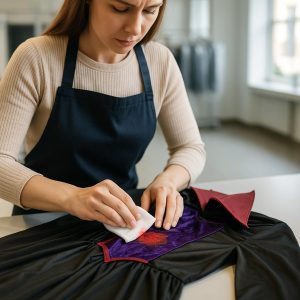 Costumes are more than clothes—they’re wearable memories, emotional investments, and sometimes even works of art. Behind each sequin, layer, and hem lies the creative energy of the person who wore it. That’s why cleaning them is not simply a matter of removing stains—it’s about preserving character, texture, and craftsmanship. Halloween costumes in particular are constructed from complex fabrics that combine synthetics, adhesives, and trims. Cleaning them requires the precision and knowledge only expert dry cleaners can provide.
Costumes are more than clothes—they’re wearable memories, emotional investments, and sometimes even works of art. Behind each sequin, layer, and hem lies the creative energy of the person who wore it. That’s why cleaning them is not simply a matter of removing stains—it’s about preserving character, texture, and craftsmanship. Halloween costumes in particular are constructed from complex fabrics that combine synthetics, adhesives, and trims. Cleaning them requires the precision and knowledge only expert dry cleaners can provide.
At Hampstead Garment Care, our process goes beyond surface cleaning. We start with a detailed fabric inspection to identify every material used, from polyester blends and velvets to faux leather and metallic finishes. Then, our team tests safe cleaning agents on small, hidden areas to ensure no colour bleeding, shrinking, or warping occurs.
-
We use biodegradable solvents specifically formulated to dissolve makeup, fake blood, sweat, and adhesive residues without damaging embellishments or dyes. These solvents are environmentally responsible, leaving no harsh chemical smell and minimising waste.
-
Each costume undergoes a careful hand examination for loose trims, torn seams, missing embellishments, or fragile sections. These are reinforced or repaired before the cleaning process begins to prevent further damage.
Every Halloween costume has a story to tell, connecting wearers to a lineage of cultural traditions that enrich our understanding of the holiday.
-
We apply hand-finishing and steaming techniques tailored to the fabric type. For example, velvet is restored with gentle brushing to maintain its pile, while lace and tulle are reshaped using low-temperature steam.
-
Costumes are then pressed, folded, and packaged using archival materials that prevent creasing and fading. We offer specialised storage solutions with breathable garment covers for long-term preservation.
-
For clients with tight schedules or last-minute events, we provide same-day and express cleaning services, ensuring your costume is ready when you need it.
Unlike home washing, which risks melting sequins or dulling metallic paints, our professional cleaning ensures every decorative feature survives intact. We also provide post-cleaning inspections to verify that colours remain vibrant and that no odours linger. Each garment leaves our facility not only clean but revived—ready to shine at the next party, theatre show, or costume event.
Whether it’s a velvet vampire cape, a latex superhero suit, or a beaded flapper dress, our experts treat every garment like a historical artefact. Because, in many ways, it truly is—a reflection of creativity, personality, and the magic of celebration.
As you prepare for the next Halloween celebration, consider the thoughtful choices you can make regarding your Halloween costumes and their care.
9. Costume Inspiration Gallery
(Suggested visuals for your blog)
Visual storytelling adds depth and connection to your article, drawing readers into the texture and evolution of Halloween fashion. Each image should do more than decorate—it should transport your audience through time and emotion.
-
Vintage ghost costume illustration (1800s): Depicting a simple sheet with cut-out eyes, this image captures the raw creativity of early Halloween traditions, before commercialisation transformed the holiday. It’s a nod to the modest, handmade origins of costume culture.
-
Early 20th-century Halloween postcard showing children in masks: These nostalgic postcards, once exchanged as seasonal greetings, often featured handmade paper masks. They reflect a time when imagination triumphed over consumerism.
-
A group of modern friends in cinematic costumes: This shot represents today’s social media-driven costume era—dynamic, photogenic, and influenced by pop culture. It also highlights diversity and community, key elements of London’s Halloween spirit.
-
Close-up of sequined fabric under a stage light: A detailed macro photo that reveals the craftsmanship of modern materials—sequins, tulle, metallic threads. This close-up helps readers visualise why these fabrics need careful handling and professional cleaning.
-
Dry cleaner at work restoring a delicate costume at the Hampstead Garment Care workshop: A behind-the-scenes glimpse of craftsmanship and care. This image tells your brand’s story—precision, skill, and respect for garments. Show the gloved hands, the controlled lighting, and the polished workspace to convey professionalism.
Consider pairing these visuals with brief captions or hover text to educate readers about the era, fabric type, or cleaning challenge featured in each image. This not only enhances SEO (through alt text and descriptions) but also enriches user experience by transforming static images into storytelling elements.
10. Conclusion: Keep the Magic Alive
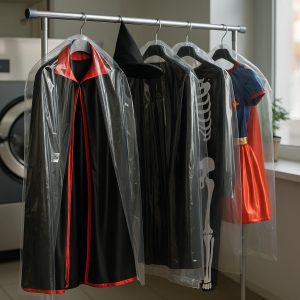 Every stitch, sparkle, and sequin in a Halloween costume tells a story. These garments connect us to centuries of tradition—from ancient rituals that honoured the dead to today’s playful embrace of fantasy. Treating your costume with care ensures those stories live on.
Every stitch, sparkle, and sequin in a Halloween costume tells a story. These garments connect us to centuries of tradition—from ancient rituals that honoured the dead to today’s playful embrace of fantasy. Treating your costume with care ensures those stories live on.
With proper care, your Halloween costumes can become beloved keepsakes that evoke memories of joyous celebrations for years to come.
At Hampstead Garment Care, we’re more than a cleaning service—we’re caretakers of fabric history. After Halloween’s excitement fades, bring your costumes to us for professional cleaning and preservation. We’ll remove the glitter, stains, and ghostly traces of the night, restoring every detail with precision.
🎃 Book your Post-Halloween Costume Care Service today in Hampstead or anywhere across London. Let our team give your costume a second life—so when the next October arrives, you’ll be ready to haunt again in style.
Take care of your Halloween costumes to keep them as vibrant as the memories they create.
👉 Book Now
Let us help you maintain the charm and allure of your Halloween costumes at every festive occasion.

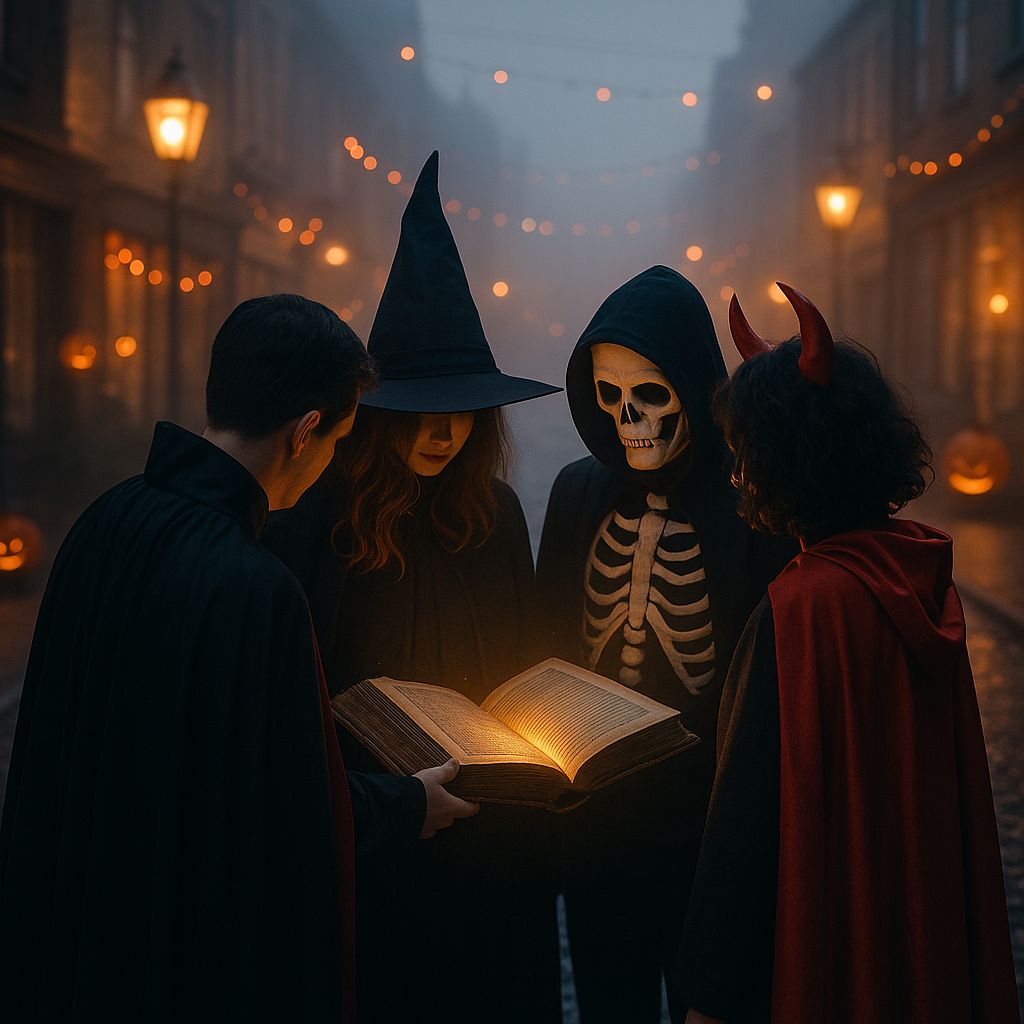


No comment